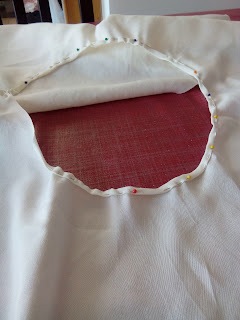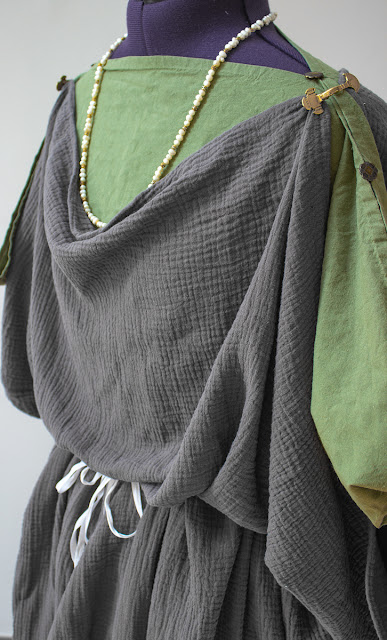IX century Anglosaxon - Norman dress
I have several sewing projects for this year, including a bunch of medieval dresses. My last medieval dress was from 2014 (the burgundy Bliaut) so I thought it was time to create something new. I always had a passion for the lines and shapes of early medieval fashion so first of all I did a little bit of research to understand how these dresses were made and cut.
The fashion of this period was not so advanced and the influence of the roman empire is still visible when looking at the cutting diagram: the dresses were cut following simple shapes, often squares, rectangles or semi-circular, and they were studied to save most fabric as possible. Women's fashion of 11th century featured two basic garments: an under dress with fitted sleeves and a knee length super tunic, including a oval veil to cover the hair. This kind of fashion works perfect for the late Anglo-Saxon period and the early Norman kingdom.
I chose brown and ivory linen for my project. I wanted something simple and practical, something completely different from my other dresses; the medium weight linen worked great for this purpose: it gives a "everyday" look and the simple linen trims add that touch of elegance perfect for lower-middle classes.
The tunic fits like a glove and it's really comfortable. The sleeves are faced inwards and there's no visible machine stitching from the outside. The super tunic falls gently on the body and looks great with or without belt; the neckline is faced outwards and every hem has been hand sewn with cotton thread and medium sized stitches. The skirts float so nicely together when moving!
The faced neckline
The veil was a challenge. It was really easy to be made (all hand sewn) but wearing it has been more difficult. I had to make several fittings before finding a nice way to drape it over the shoulders, the secret is to put the longest part of the veil on the head and then wearing a leather or metal crown to keep it secured on the head; the shorter part needs to be draped on the shoulders or tucked behind the neck. The important is to hide the hair completely and - very important - the ears: this might sound strange but covering the ears was not only a sign of modesty but a way to protect women from...pregnancies (during Middle Ages it was widely believed the Virgin Mary was inseminated by the Holy Spirit through her ear).
A version of the dress without all the trim
To complete the outfit I sewn a white under dress in fine lightweight linen as well. This piece has a modern construction on the inside but the outer elements have been all hand sewn.
I'm often asked if chemise (or shifts) are important when recreating an historical garment; the answer is yes, absolutely. Chemises/shifts/under dresses are the foundation of an accurate, well-made garment and they make the difference. First of all, they are the foundation of your wardrobe as you lived in this garment; people was supposed to own a bunch of these which were frequently washed,. They lived in an era when human bathing was not frequent. The chemise helped you to protect not only your body but your outer clothes too (often more expensive), acting as a barrier and keeping them clean from dirt and body oils. So yeah, when purchasing/sewing an historical outfit please don't forget to add a chemise as basic undergarment.
And so here I am, wearing the whole outfit during my latest costume exhibition :)
The items are listed on our Etsy shop and are available in three different standard sizes (S, M, L).
Thanks for reading!
The items are listed on our Etsy shop and are available in three different standard sizes (S, M, L).
Thanks for reading!










Commenti
Posta un commento